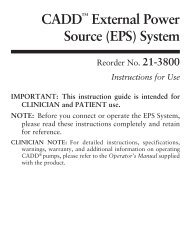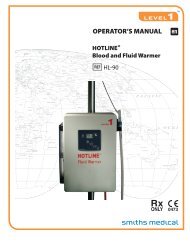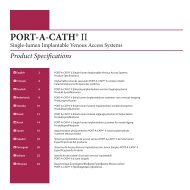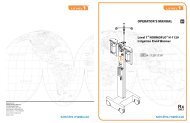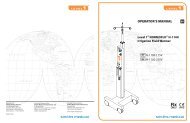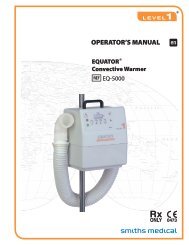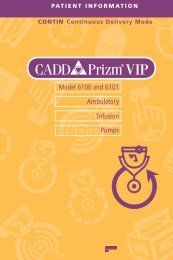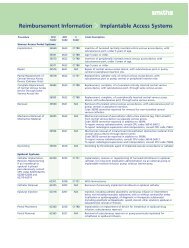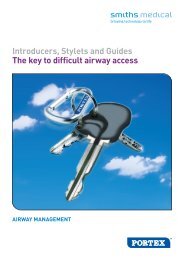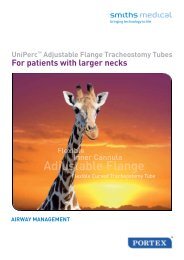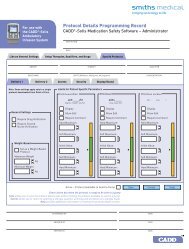40-5124-24C IFU, ProPort.indd - Smiths Medical
40-5124-24C IFU, ProPort.indd - Smiths Medical
40-5124-24C IFU, ProPort.indd - Smiths Medical
Create successful ePaper yourself
Turn your PDF publications into a flip-book with our unique Google optimized e-Paper software.
[en]<br />
TABLE OF CONTENTS PAGE<br />
I. INTRODUCTION ........................................................................................ 3<br />
A. Product Description ................................................................................................... 3<br />
B. Indications for Use ..................................................................................................... 3<br />
C. Contraindications ....................................................................................................... 3<br />
D. Potential Complications ............................................................................................ 3<br />
II. WARNINGS ................................................................................................ 4<br />
III. PRE-IMPLANTATION CONSIDERATIONS ................................................. 4<br />
A. Preparation of the System ......................................................................................... 4<br />
A.1 Unassembled Systems ....................................................................................... 4<br />
A.2 Pre-assembled or Preconnected Systems ...................................................... 4<br />
IV. CATHETER PLACEMENT TECHNIQUES ..................................................... 4<br />
A. Percutaneous Puncture – Method A (Interventional Radiologists) ................. 5<br />
B. Percutaneous Puncture – Method B (Surgeons) .................................................. 5<br />
C. Surgical Cutdown ....................................................................................................... 6<br />
V. PORTAL AND SITE PREPARATION ............................................................. 6<br />
A. Prepare Subcutaneous Pocket .................................................................................. 6<br />
B. Catheter-Portal Assembly ......................................................................................... 6<br />
B.1 SlideLock Connector ...................................................................................... 6<br />
B.2 CATH-SHIELD® Connector ............................................................................ 6<br />
C. Flow Check ................................................................................................................... 6<br />
D. Site Closure .................................................................................................................. 7<br />
E. Postoperative Care ...................................................................................................... 7<br />
VI. INSTRUCTIONS FOR SYSTEM ACCESS ...................................................... 7<br />
A. Determining System Integrity ................................................................................. 7<br />
A.1 System Integrity is Verified – Portal Will Not Be Used Immediately ..... 7<br />
A.2 System Integrity Is Verified – Injection Or Infusion Will Be Initiated<br />
Immediately ........................................................................................................ 7<br />
B. Flushing Schedule ....................................................................................................... 8<br />
C. Blood Sampling Procedure (Venous Systems Only) ............................................ 8<br />
D. Discontinuing System Use ........................................................................................ 8<br />
E. References ..................................................................................................................... 8<br />
FIGURES .......................................................................................................... 77<br />
I. INTRODUCTION<br />
<strong>ProPort</strong> implantable venous access systems can be placed in the chest and<br />
are designed to permit repeated access to the venous system for the parenteral<br />
delivery of medications, fluids, and nutritional solutions and for the sampling of<br />
venous blood. These devices should be implanted only by clinicians experienced<br />
or trained in the implantation and maintenance of venous access devices and<br />
knowledgeable of the risks.<br />
PRECAUTION: Patients who engage in occupations, or in physical activities,<br />
such as golfing, swimming, or weight lifting, which involve excessive and /or<br />
repetitive upper extremity and/or shoulder or pectoral girdle motion, should<br />
be informed that such activity may increase the possibility of catheter fragmentation<br />
due to compression of the catheter between the clavicle and first rib<br />
(catheter pinch-off syndrome).<br />
The figures referred to in this manual are found on a fold-out page inside the back<br />
cover. Specifications for the portal and catheter are listed in the Product Specifications<br />
booklet packaged with the product.<br />
Patient Information and Clinician Information booklets can be obtained by contacting<br />
<strong>Smiths</strong> <strong>Medical</strong> MD, Inc. in the U.S. at 1 800.426.2448 or <strong>Smiths</strong> <strong>Medical</strong> International<br />
Ltd. the EU Authorized Representative at Tel +44 (0)1923 246434.<br />
A. Product Description<br />
<strong>ProPort</strong> systems are supplied sterile (EtO sterilized) and non-pyrogenic. All<br />
<strong>ProPort</strong> products are designed and intended for single-patient use only. A<br />
<strong>ProPort</strong> system consists of a portal with a self-sealing septum and a single-lumen<br />
catheter and is accessible by percutaneous puncture with a non-coring needle.<br />
Systems are also available with introducer sets.<br />
B. Indications for Use<br />
<strong>ProPort</strong> systems are indicated when patient therapy requires repeated venous<br />
access for injection or infusion therapy and/or venous blood sampling.<br />
C. Contraindications<br />
<strong>ProPort</strong> systems are contraindicated for patient therapy whenever:<br />
The presence of infection, bacteremia, or septicemia is known or suspected.<br />
The patient’s anatomy will not permit introduction of the catheter into a<br />
vessel.<br />
The patient has severe chronic obstructive pulmonary disease (COPD) (chest<br />
placement only).<br />
The patient has undergone past irradiation of the upper chest area (chest<br />
placement only).<br />
The patient is known to have, or is suspected to have, an allergic reaction<br />
to materials contained in the system or has exhibited a prior intolerance to<br />
implanted devices. (System materials are listed in the Product Specifications<br />
booklet and on the package label.)<br />
Substances are used for patient therapy that are incompatible with any of the<br />
system’s components. (System materials are listed in the Product Specifications<br />
booklet and on the package label.)<br />
Do not use this product if the package has been previously opened or damaged.<br />
D. Potential Complications<br />
Use of the system involves potential risks normally associated with the insertion<br />
or use of any implanted device or indwelling catheter, including but not limited<br />
to those listed below:<br />
Air embolism<br />
Arteriovenous fistula<br />
Artery or vein damage/injury<br />
Brachial plexus injury<br />
Cardiac arrhythmia<br />
Cardiac puncture<br />
Cardiac tamponade<br />
Catheter disconnection, fragmentation, fracture, or shearing with possible<br />
embolization of the catheter 1,2,3,4,5,6,7,8<br />
•<br />
•<br />
•<br />
•<br />
•<br />
•<br />
•<br />
•<br />
•<br />
•<br />
•<br />
•<br />
•<br />
•<br />
• Catheter occlusion<br />
• Catheter rupture<br />
• Drug extravasation<br />
• Erosion of portal/catheter through skin and/or blood vessel<br />
• Fibrin sheath formation around catheter tip<br />
• Hematoma<br />
• Hemothorax<br />
• Implant rejection<br />
• Infection/bacteremia/sepsis<br />
• Migration of portal/catheter<br />
• Nerve damage<br />
3



